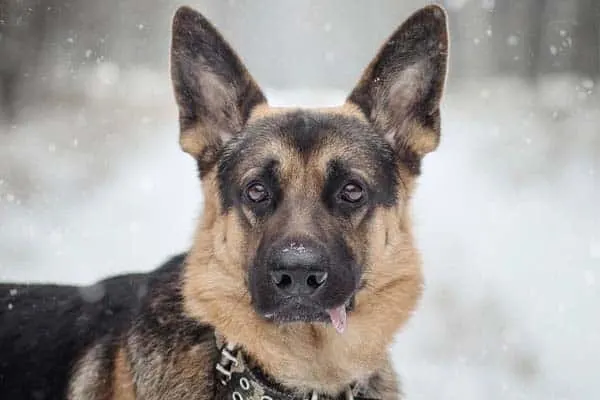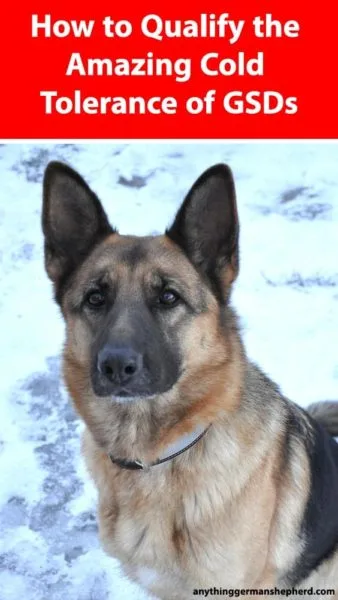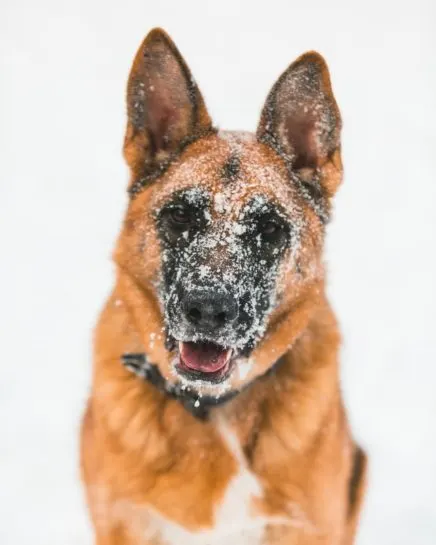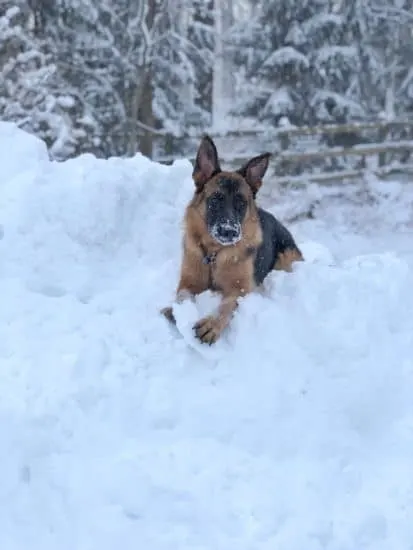How to Qualify the Amazing Cold Tolerance of GSDs
Have you ever had that oops moment when you went to the store and left the dog outside only to witness the temperature take a sudden nosedive? But you have a German Shepherd. He should be fine, right?
How cold is too cold for a German Shepherd?
Your dog’s temperature tolerance might be different from other German Shepherds, as it differs between dogs. Generally speaking, 40 degrees Fahrenheit is too cold for German Shepherds to be out in for significant periods of time.
While they might tolerate it for a walk, they shouldn’t be left outside in these weather conditions for a long period of time.
A German Shepherd’s versatility extends to his cold-weather tolerance. A heavy fur coat and large body mass keep him warm even as temperatures outside plummet to below freezing.
We will go over other specific adaptations that prepare German Shepherds for frigid temperatures, how cold they can go, and what you can do to help.

What naturally prepares your Shepherd for cold weather?
Your German Shepherd has a few characteristics and instinctual behaviors that will help keep her warm.
Shepherds have a thick double-coat.
Most German Shepherds have a medium-length outer layer of guard hairs with a thick fleecy undercoat.
Their outer coat is dense and the stiff hairs usually lie flat. Orvis News points out this coarseness also means the coat has a water-repellant quality.
Your Shepherd’s undercoat should be similar to thick down. Its purpose is insulation, and it serves GSDs in both hot and cold weather. In the frigid cold, the undercoat is further insurance that body heat does not escape.
You should note that German Shepherds can have three varieties of coat lengths in addition to the standard plush.
- Short outer coat with a normal thick undercoat.
- Long-haired with an undercoat – These dogs also have feathering which consists of tufts on the ears and pants on the hind legs. Their hair will be much thicker in appearance than other feathered breeds like the Golden Retriever.
- Long-haired dog with no undercoat
A German Shepherd has a low surface area.
Bergmann’s Rule, according to Britannica, is the phenomenon whereby a large animal has a low surface-area-to-volume ratio relative to a small one.
Animals living in colder climates often have a larger body mass than those who do not.
Have you ever wondered why a Chihuahua struggles to stay warm at 45 degrees Fahrenheit while a Labrador seems in Paradise? It is not solely because of their coat. Large-breed dogs have less surface area over which heat can escape.
Per the AKC, the breed standard for the German Shepherd calls for a height of 22 to 26 inches at the top of the shoulders and a weight of 50 to 90 pounds.
As you probably know, many Shepherds are much larger than the breed standard.
Muscles keep your dog warm.
Although not as buff as a Staffordshire Terrier or Bull Mastiff, your Shepherd has great muscling under his fur.
Muscles generate heat through metabolism and as a last resort through effective shivering.
Dogs have special attributes to keep warm.
According to Dog Discoveries, all dogs have basic traits and behaviors to stay warm when it is cold out. Your German Shepherd is better adapted than some other breeds.
- Bushy tail to cover face when sleeping – Dogs will often sleep in a curled position to minimize heat loss and GSDs have exceptionally bushy tails to keep nose and eyes warm.
- A counter-current heat exchanger in paws – A network of blood vessels maintains heat in a dog’s paws similar to a penguin’s feet.
- Piloerection – When your German Shepherd puffs up, her guard hairs and undercoat trap cold air away from her skin and body.
What decreases your German Shepherd’s ability to handle the cold?
A German Shepherd in his prime can handle temperatures 20 degrees Fahrenheit fairly easily. He can tolerate temperatures even as low as -10 to -15 degrees Fahrenheit for short periods and as long as he stays dry.
Some Shepherds should not be exposed to extremely cold temperatures because of their decreased ability to cope.
Puppies – Very young dogs are small, lack muscle mass, have minimal body fat, do not have a proper fur coat, and have underdeveloped temperature regulation centers in the brain.
They cannot shiver effectively and have a large surface-area-to-body-volume ratio.
Senior dogs – Aging dogs lose muscle mass and immune functions and sometimes their hair. Do not subject elder dogs to extremes in temperature for long periods.
Sick dogs – Dealing with the energy needs of an illness, especially chronic, prevents your German Shepherd from handling cold weather effectively. Chronic illness may lead to loss of muscle and fat.
Dogs without an undercoat – If your dog does not have an undercoat, avoid prolonged exposure to temperatures below freezing, regardless of his coat length.
Dogs lacking condition – Dogs who are malnourished or suffering from another cause of weight loss do not have the energy stores to cope when it is exceedingly cold outside.
Even a balmy 45 degrees Fahrenheit may be too cold for them.

What do you need to provide your dog when it is cold?
Have you acclimated your dog to cold weather? Even if your dog is accustomed to staying outdoors in all conditions for eight to 12 hours, she needs basic amenities.
Not only is it the law in many areas, but it ensures her comfort and well-being.
Freshwater – Although it seems common sense, water provides the hydration necessary for all metabolic processes, including staying warm.
Shelter – Your German Shepherd needs shelter from the wind. A doghouse will also protect from rain, sleet, and snow, and provides additional insulation. An appropriate size will trap your dog’s body heat inside, although some still need heaters depending on where you live.
- Cabin dog houses sealed protective coating, raised floor, & slanted asphalt roof provide protection from the elements and keep the cabin comfortable & dry.
Bedding – hay, and straw, as well as blankets and clothing, can provide additional insulation.
Proper nutrition – Staying warm requires a lot of fuel.
Supervise and prevent the ingestion of de-icing salt. Rinse feet after walking on salted surfaces.
How do you know your Shepherd cannot handle the cold?
No matter how adaptable your German Shepherd is, always stay attuned to what his body language is telling you. You may see several signs your dog is having a hard time with cold weather.
- Shivering – Shivering is a survival mechanism and generally indicates your dog’s core boy temperature is falling.
- Burrowing – Nesting and burrowing into the bedding to get comfortable is normal. If your dog persists, he may be letting you know it is time to come inside.
- Anxiety and whining – Do not ignore your dog if she seems in any kind of distress.
- Unusual and sudden lethargy or sluggishness – This is a serious indicator of hypothermia.
All dogs have limits where cold weather is concerned. Shepherds who have not acclimated to cold temperatures should not be left outside.
The following videos have been included to show contrasting body language.
This Shepherd is clearly excited and happy to be outside. Notice how the coat keeps the snow away from the dog’s body and repels moisture.
The snow does not melt because the fur keeps it away from the body. This GSD is active, further warming him. Watch the first video.
This German Shepherd is not as exuberant as the former but is not showing any distress with the cold weather.
She may need to come in soon, however, based on the snow accumulating on her fur, her immobility, and her low tail set. She is also showing piloerection along the neck. Watch the second video.
What are the signs of hypothermia?
- Your dog shivers and then suddenly stops but does not appear any happier.
- Weakness – Your dog may seem disoriented or dull.
- Dilated pupils
- Pale or bluish mucous membranes – inside eyelids or gums
- Labored respiration
Hypothermia can lead to frostbite and even worse, coma and death.
What should you do if your Shepherd gets too cold?
If you suspect your GSD has hypothermia, call a veterinarian, but you will need to start treatment immediately. Bring your dog into a warm environment and check her temperature.
The most common cause of hypothermia is prolonged exposure to the elements and wet fur. Dry your German Shepherd thoroughly, using a hairdryer if necessary.
Wrap her in a warm dry blanket, even utilizing hot water bottles.
Only use heating pads if your pet is dry and under supervision. Having an accurate thermometer is crucial.
| Image | Title | Buy |
|---|---|---|
 | Attmu Classic Rubber Transparent Hot Water Bottle 2 Liter with Knit Cover - Blue | Buy Now |
 | ADC Veterinary Thermometer, Dual Scale, Adtemp 422 | Buy Now |
What laws protect your German Shepherd?
Your pet is extremely important to you and governing bodies are taking ever-increasing notice of animal rights. As a result, many states have foregone trying to determine what extremes of the cold any dog can tolerate.
Laws applying to how long dogs can stay outside in cold weather are often blanket regulations that do not distinguish specific breeds.
Some establish biological suitability for certain groups that can live outside with a proper set-up.
Here are dog breeds generally considered suited to cold weather, according to the Humane Society of Utah. German Shepherds may not be on all lists.
- Spitz breeds – Chow Chows, Siberian Husky, Malamute
- St. Bernard – may include similar breeds such as Newfoundland
- Sheepdogs – Note, German Shepherds may not be sheepdogs under some classifications. However, most of them include Collies, Old English Sheepdogs, and various Shepherds.
Familiarize yourself with state statutes in your areas. Many use a threshold of 32 degrees Fahrenheit, below which a dog cannot be outside for more than thirty minutes at a time.

Do German Shepherds Get Cold?
Yes and no. While their core body temperature will be able to stay at normal levels, other areas of their body, like their paws, are more susceptible to the cold.
While it is difficult to nail down what is too cold, German Shepherds are among the top 20 cold-weather dogs according to Outside Online and other sources. Every dog, however, is an individual.
Safe management of German Shepherds outside in frigid temperatures requires common sense practices regarding below-freezing conditions, recognition of body language that reflects distress, and heeding the base health and condition of your pet.
Due to their thick, double coats and robust bodies, German Shepherds tend to cope better with the cold weather in comparison to hot. In fact, they tolerate cold temperatures better than the majority of dog breeds.
This is thanks to their double coats. While the undercoat functions as insulation to prevent heat from escaping the body, the outer coat acts as a guard to repel moisture and to keep the cold from reaching the body.
While German Shepherds tend to enjoy the snow, don’t forget that your dog may not even notice that they are getting too cold.
It is your responsibility to keep an eye on the time and closely watch your dog’s behavior to ensure that they are safe when you’re out and about in the cold weather.
It’s safest to limit their time in the snow to about 30 minutes at a time. However, if it’s a sunny warm day and the snow has begun to melt, then you might want to allow your dogs to stay out a little while longer.
Be mindful that your dog’s tolerance to the temperature might differ, as it’s different for each dog.
That being said, you should always make sure that you’re keeping a close eye on them.
Although the air temperature might feel warm to you, your pooch is still walking on the frozen ground and their paws are still susceptible to freezing on the ice and snow.































